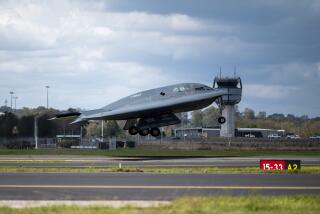Op-Ed: The drone warfare drawbacks

- Share via
The drone has become America’s counter-terrorism weapon of choice. But does drone warfare really further U.S. goals abroad?
To wartime strategists under both George W. Bush and Barack Obama, the new weapon, like many innovations in the history of military technology, seemed at first like a silver bullet.
Drones with lethal missiles could hover for hours over potential targets, waiting for the moment to strike. They could kill suspected terrorists with relative precision, though not, as the CIA claimed in 2011, without any civilian casualties. Best of all, drones didn’t endanger American lives; the pilots were safe and snug in Djibouti or Nevada.
In an almost-invisible campaign that started modestly under Bush and expanded dramatically under Obama, the U.S. has launched more than 1,600 drone strikes in Afghanistan, Iraq, Pakistan, Yemen, Somalia, Libya and even, in one case, in the Philippines, according to Micah Zenko of the Council on Foreign Relations.
But consider how those drone strikes appear if you are an ordinary civilian in, say, northwestern Pakistan. You know you are in constant danger; a missile may strike your home at any time without warning. It’s not clear who’s shooting; the war and its combatants are officially secret. It’s not clear how you can avoid becoming a target; members of Al Qaeda are fair game, of course, but what are their neighbors and cousins and grocery suppliers to do? And if something goes awry, there’s no one to complain to; the CIA doesn’t have a customer service desk, and the government of Pakistan claims (falsely, in most cases) that it has no control over foreign missile strikes.
Drone strikes may be an efficient way to kill terrorists, but they’re no way to make friends.
That’s one of the messages of a stinging new report issued recently by a panel of experts convened by Washington’s independent Stimson Center, a thoroughly establishment group of former officials from both Democratic and Republican administrations. Blue-ribbon commissions in Washington often pull their punches; this one, chaired by retired Army Gen. John P. Abizaid and former Pentagon official Rosa Brooks, didn’t. Among its highlights:
Just because drone wars have succeeded in killing terrorists doesn’t mean they’re working. “The Obama administration’s heavy reliance on targeted killings as a pillar of U.S. counter-terrorism strategy rests on questionable assumptions and risks increasing instability,” the report warns. After a decade of drone strikes, it notes, we face more Islamic extremists, not fewer.
The widespread use of drones has created a backlash around the world, and not only in remote villages in Pakistan or Yemen. The report quotes retired Gen. Stanley McChrystal, the former U.S. commander in Afghanistan, warning that the tactic creates resentment “much greater than the average American appreciates.”
Reliance on drones for “targeted killing” has allowed the CIA and Pentagon to obscure exactly whom we are fighting. About the only thing the Obama administration has said on the subject is that it has aimed the drone program at “Al Qaeda and associated forces.” But, as the report notes, while U.S. targeters may exercise great care in their decisions, the drone attacks still look perilously like “a secret war, governed by secret law.”
Our drone policy could come back to haunt us once the U.S. loses its current near-monopoly in drone technology. China and Iran are already working on military drones, and Russia is unlikely to be far behind. If Vladimir Putin decided to use drones against anti-Russian militants in Ukraine, the report notes, “Russia could simply repeat the words used by U.S. officials defending U.S. targeted killings, asserting that it could not provide any evidence without disclosing sources and methods.”
The ease of using drones makes them seductively tempting to deploy. “The increasing use of lethal drones may create a slippery slope leading to continual or wider wars,” the panel warned. “[Drones] may lower the bar to enter a conflict, without increasing the likelihood of a satisfactory outcome.” Obama has assiduously avoided one slippery slope, the one that leads to putting U.S. troops on the ground, but he’s presided over the creation of another.
Given all those issues, the report notes, it might be a good moment for a pause in the drone wars. But don’t hold your breath waiting for that to happen.
Many of the Stimson Center’s findings “resonate with the administration’s current policy,” National Security Council spokeswoman Caitlin Hayden told me last week. “As the president said last month at West Point, the United States ‘must be more transparent about both the basis of our counter-terrorism actions and the manner in which they are carried out.’”
But that doesn’t mean the administration plans to abandon drone warfare. It has already said it may soon use the missiles on a new battlefield against the Islamic State of Iraq and Syria, which has shortened its name to Islamic State.
The Stimson Center report gives the administration a smart list of policy proposals: a systematic review of drones’ costs and benefits; a commission on targeting, to show that we’re very careful about whom we kill; and an effort to establish international norms, so when Russia and Iran get drones some basic rules are in place.
I’ll add one more: The administration should make public its enemies list. It’s past time that the U.S. disclosed a list of organizations that qualify as “Al Qaeda associates,” and thus as legitimate targets for U.S. attack. If secrecy is necessary in some cases, keep those secret. But even a partial list would be better than we have now: a secret war governed by secret law.
[email protected]
Twitter: @DoyleMcManus
More to Read
A cure for the common opinion
Get thought-provoking perspectives with our weekly newsletter.
You may occasionally receive promotional content from the Los Angeles Times.











